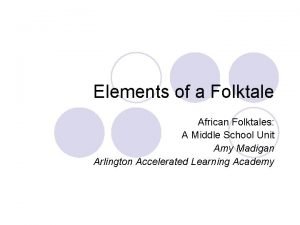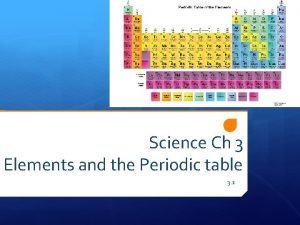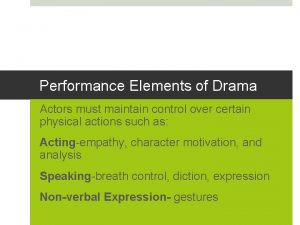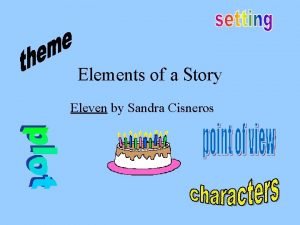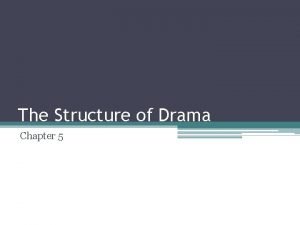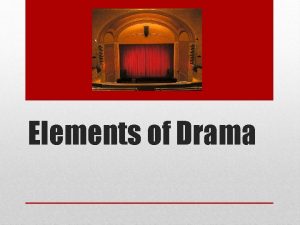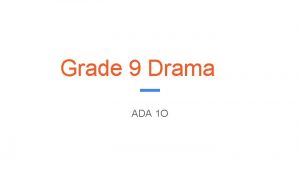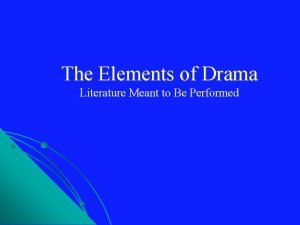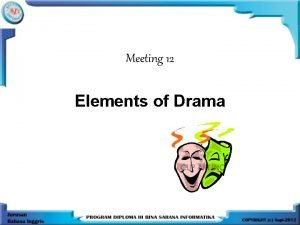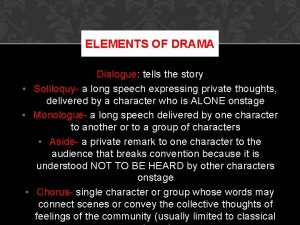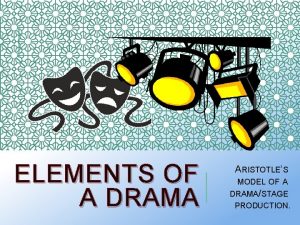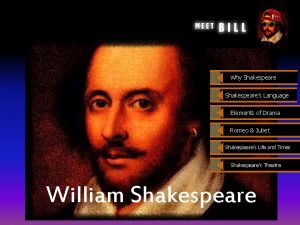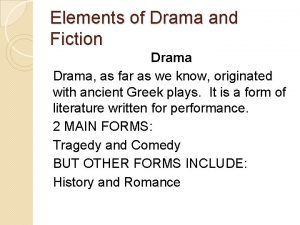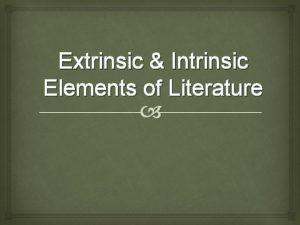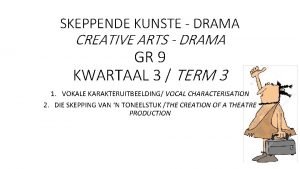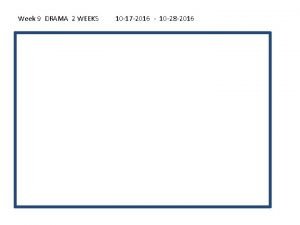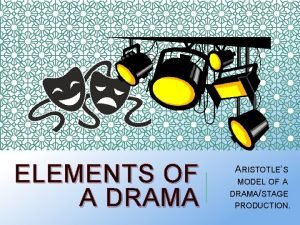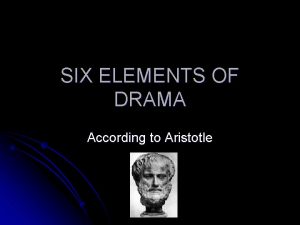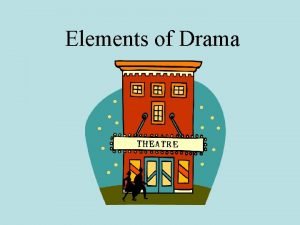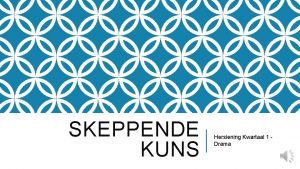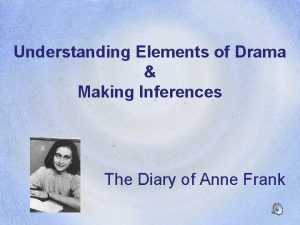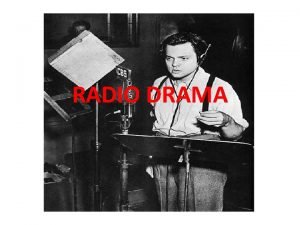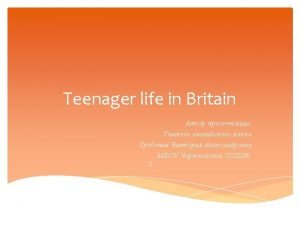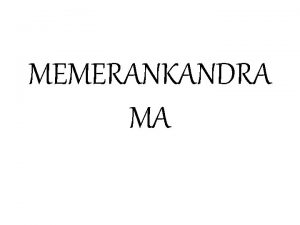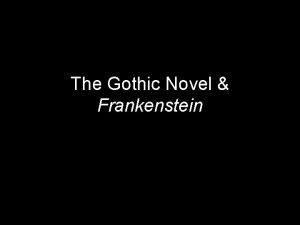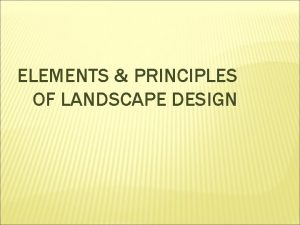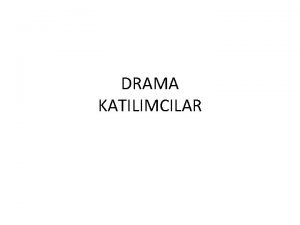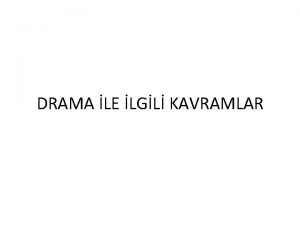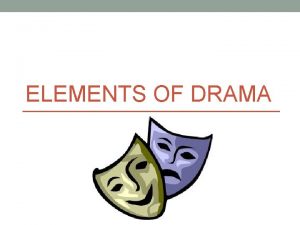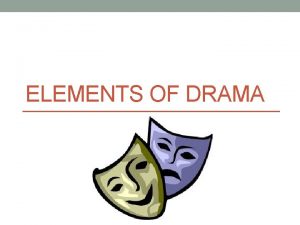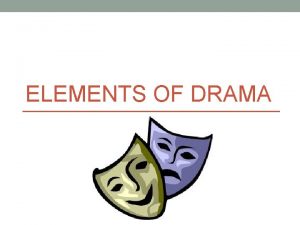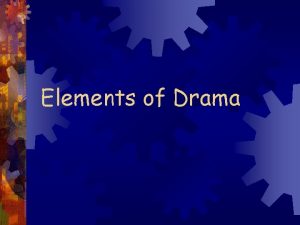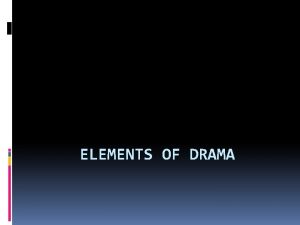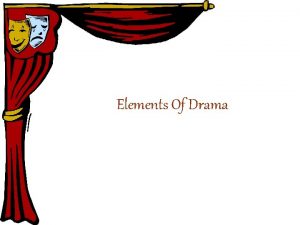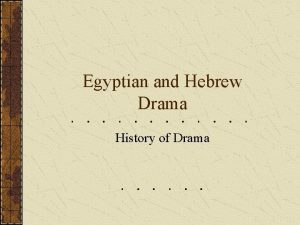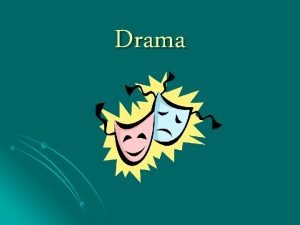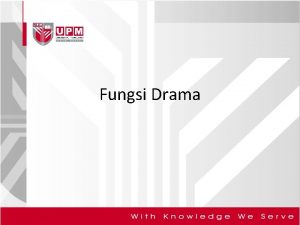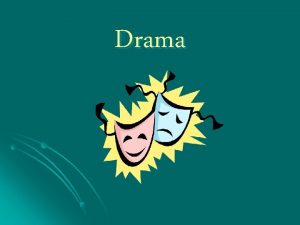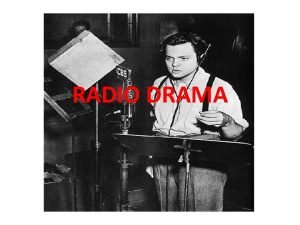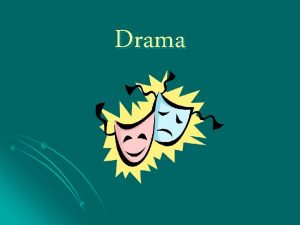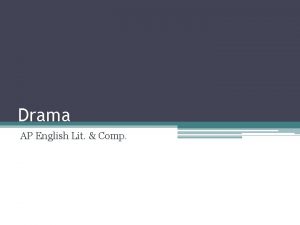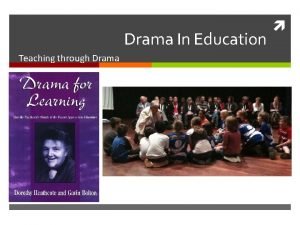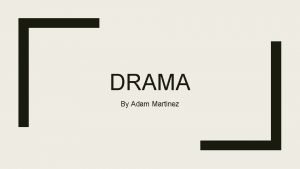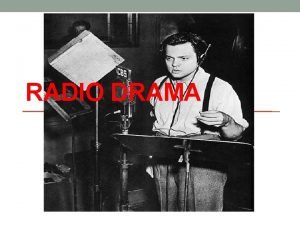Elements of Drama What Is Drama A drama






















![Stage Directions ® Found in brackets [ ] or italics. ® Describe scenery and Stage Directions ® Found in brackets [ ] or italics. ® Describe scenery and](https://slidetodoc.com/presentation_image/5d9472b2c5be892302821bae3f59a2a5/image-23.jpg)










- Slides: 33

Elements of Drama

What Is Drama? A drama is a story enacted onstage for a live audience.

Setting the Stages can have many different sizes and layouts. “Thrust” stage • The stage extends into the viewing area. • The audience surrounds the stage on three sides.

Setting the Stage “In the round” stage is surrounded by an audience on all sides.

Setting the Stage Proscenium stage • The playing area extends behind an opening called a “proscenium arch. ” • The audience sits on one side looking into the action. upstage right stage left downstage

Setting the Stages in Shakespeare’s time were thrust stages.

Tragedy ﻣﺄﺴﺎﺓ A tragedy is a play that ends unhappily. • Most classic Greek tragedies deal with serious, universal themes such as right and wrong justice and injustice life and death • Tragedies pit human limitations against the larger forces of destiny.

Tragedy The protagonist of most classical tragedies is a tragic hero. This hero • is noble and in many ways admirable • has a tragic flaw, a personal failing that leads to a tragic end pride rebelliousness jealousy

Comedy ﻫﺰﻟﻴﺔ ﻣﺴﺮﺣﻴﺔ A comedy is a play that ends happily. The plot usually centers on a romantic conflict. boy meets girl boy loses girl boy wins girl

Comedy The main characters in a comedy could be anyone: nobility townspeople servants

Literary Elements Theme: the basic idea of a play; the idea, point of view, or perception that binds together a work of art. ﺍﻟﺮﺋﻴﺴﺔ ﺍﻟﻔﻜﺮﺓ Language: in drama, the particular manner of verbal expression, the diction or style of writing, or the speech or phrasing that suggests a class or profession or type of character. ﺍﻟﻠﻐﺔ Style: the shaping of dramatic material, settings, or costumes in a deliberately nonrealistic manner. ﺍﻟﻤﻈﻬﺮ

Literary Elements Characters/Characteriza tion The actors in a story’s plot. ﺍﻟﺸﺨﺼﻴﺎﺕ The protagonist is the main character, the character who has a conflict that is resolved in the end. ﺍﻟﺒﻄﻞ The antagonist is in conflict with

Foil ® A character who provides a strong contrast to another character. ﻣﻐﺎﻳﺮﺓ ﺷﺨﺼﻴﺔ Function of Foil Characters ® A foil may emphasize another character’s distinctive traits or make a character look better by comparison.

Plot: the series of events that take place in a play. There are 5 stages in a plot structure: Exposition introduces the story’s characters, setting and conflict. Rising action occurs as complications, twists, or intensifications of the conflict occur. Climax is the emotional high point of the story or play. Falling action is the logical result of the climax.

Dramatic Structure Like the plot of a story, the plot of a play involves characters who face a problem or conflict. Climax Complications tension builds Exposition characters and conflict are introduced point of highest tension; action determines how the conflict will be resolved Resolution conflict is resolved; play ends

Dramatic Structure Conflict is a struggle or clash between opposing characters or forces. A conflict may develop. . . ﺍﻟﺼﺮﺍﻉ q q q between characters who want different things or the same thing between a character and his or her circumstances within a character who is torn by competing desires

Speech The characters’ speech may take any of the following forms. Dialogue: conversations of characters onstage ﺣﻮﺍﺭ Monologue: a long speech made by one actor; a monologue may be delivered alone or in the presence of others. ﻓﺮﺩﻳﺔ ﻣﻨﺎﺟﺎﺓ Soliloquy: speech by a character alone onstage to himself or herself or to the audience ﺍﻟﻨﻔﺲ ﻣﻨﺎﺟﺎﺓ Asides: remarks made to the audience or to one character; the other characters onstage do not hear an aside ﺍﻟﺠﺎﻧﺒﻴﺔ ﺍﻟﺘﻌﻠﻴﻘﺎﺕ

Dialogue ﺣﻮﺍﺭ ® A conversation between characters in a literary work.

Function of Dialogue ® Dialogue brings characters to life by revealing their personalities and by showing what they are thinking and feeling as they react to other characters.

Monologues ﻓﺮﺩﻳﺔ ﻣﻨﺎﺟﺎﺓ ® Monologue: a long speech made by one actor; a monologue may be delivered alone or in the presence of others. An example is Hamlet’s well-known monologue: To be, or not to be- that is the question: Whether 'tis nobler in the mind to suffer The slings and arrows of outrageous fortune Or to take arms against a sea of troubles, And by opposing end them. (III i 64)

Soliloquies ﺍﻟﻨﻔﺲ ﻣﻨﺎﺟﺎﺓ ® A long speech delivered by a character who is alone onstage. Function of Soliloquies A soliloquy typically reveals the private thoughts and emotions of the character. An example is Juliet’s soliloquy: ® The clock struck nine when I did send the nurse; In half an hour she promised to return. Perchance she cannot meet him: that's not so. O, she is lame! love's heralds should be thoughts, Which ten times faster glide than the sun's beams (II v 1 -5)

Asides ﺍﻟﺠﺎﻧﺒﻴﺔ ﺍﻟﺘﻌﻠﻴﻘﺎﺕ ® In a play, a comment made by a character, but is not heard by the other characters onstage. Function of Asides ® Asides are frequently used to provide information to the audience and to reveal the private thoughts of characters.
![Stage Directions Found in brackets or italics Describe scenery and Stage Directions ® Found in brackets [ ] or italics. ® Describe scenery and](https://slidetodoc.com/presentation_image/5d9472b2c5be892302821bae3f59a2a5/image-23.jpg)
Stage Directions ® Found in brackets [ ] or italics. ® Describe scenery and how characters speak ® C, Center Stage ® L, Stage Left ® R, Stage Right ® U, Upstage or Rear ® D, Downstage or Front

Performance of a Play When you read a play, remember that it is meant to be performed for an audience. Stage Directions Playwright describes setting and characters’ actions and manner. [Wyona is sitting on the couch. She sees Paul and jumps to her feet. ] Wyona. [Angrily. ] What do you want? Performance l Theater artists bring the playwright’s vision to life on the stage. l The audience responds to the play and shares the experience.

Technical Elements Scenery Set Costumes Props Lighting Sound/ Music Make-up

Scene Design ® Plays are divided into acts ﻓﺼﻞ and scenes ﻣﺸﻬﺪ , which indicate a change in location or the passage of time.

Function of the Scene Design ® The scene design allows the author of the play to create a sense of Setting.

Setting the Stage Scene design transforms a bare stage into the world of the play. Scene design consists of • sets • lighting • costumes • props

Set ® Construction on the stage that shows time/place ® Could be called Scenery Setting the Stage A stage’s set might be: abstract and minimal realistic and detailed

Setting the Stage The costume director works with the director to design the actors’ costumes. • Like sets, costumes can be detailed minimal

Setting the Stage Props (short for properties) are items that the characters carry or handle onstage. • The person in charge of props must make sure that the right props are available to the actors at the right moments.

Technical Elements Lights: the placement, intensity, and color of lights to Help communicate environment, mood, or feeling Sound: the effects an audience hears during performance to communicate character, context, or environment Makeup: costumes, wigs, and body paint used to transform an actor into a character.

The Audience Finally, a play needs an audience to experience the performance understand the story respond to the characters
 Elements and sub elements
Elements and sub elements Elements of a folk tale
Elements of a folk tale Atomic elements vs molecular elements
Atomic elements vs molecular elements Http //elements.wlonk.com/elements table.htm
Http //elements.wlonk.com/elements table.htm The main elements of drama
The main elements of drama Four main types of folktales
Four main types of folktales Performance element
Performance element Eleven story plot diagram
Eleven story plot diagram Chapter 5 the structure of drama
Chapter 5 the structure of drama Key features of drama
Key features of drama Ada1o
Ada1o Elements of drama in literature
Elements of drama in literature Elements of drama in english literature
Elements of drama in english literature Vocal techniques
Vocal techniques Elements of drama dialogue
Elements of drama dialogue 6 elements of drama
6 elements of drama Romeo and juliet
Romeo and juliet Drama microfiction
Drama microfiction Intrinsic and extrinsic elements of literature
Intrinsic and extrinsic elements of literature Elemente van drama graad 8
Elemente van drama graad 8 Elements of drama foldable
Elements of drama foldable 6 elements of drama
6 elements of drama What are the six elements of drama?
What are the six elements of drama? Technical elements of drama
Technical elements of drama Basic elements of musical play/theatre
Basic elements of musical play/theatre Plot in drama
Plot in drama Resonansie betekenis
Resonansie betekenis Elements of drama
Elements of drama History of radio drama
History of radio drama Soap opera serial
Soap opera serial Berasal dari
Berasal dari Eğitici drama ve yaratıcı drama arasındaki fark
Eğitici drama ve yaratıcı drama arasındaki fark Romantic and gothic elements in frankenstein
Romantic and gothic elements in frankenstein Elements and principles of landscape design
Elements and principles of landscape design

